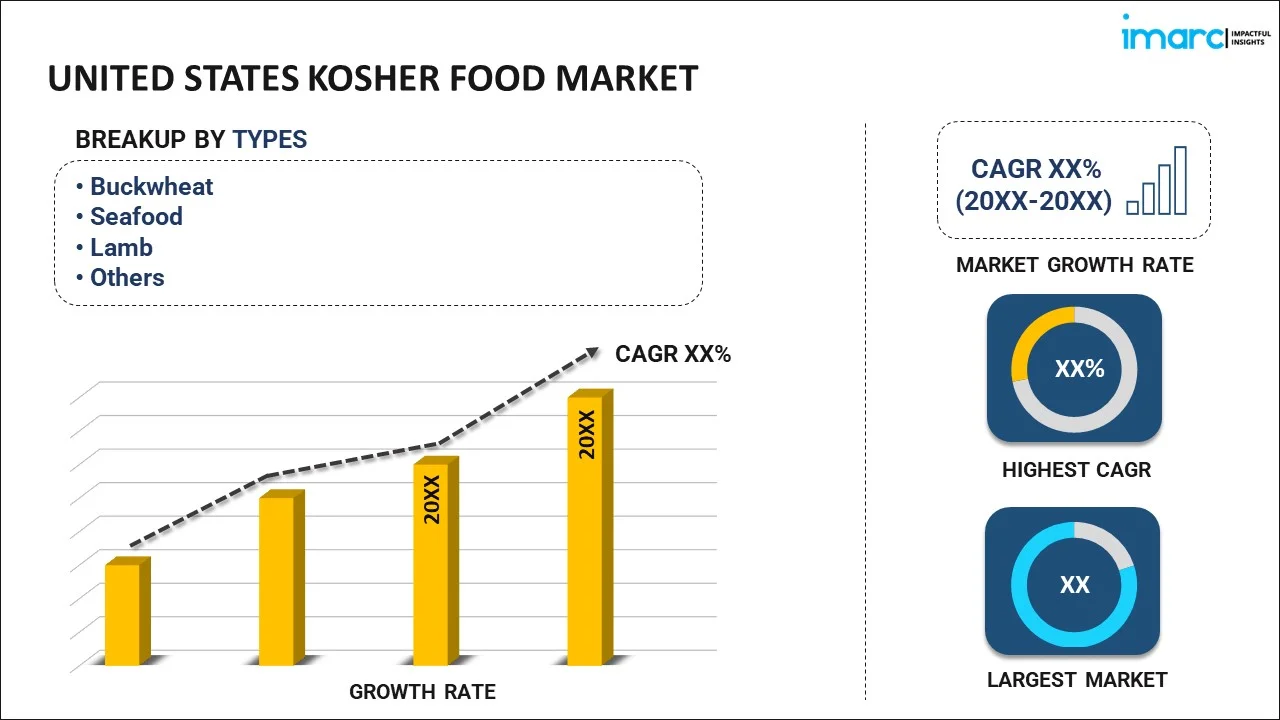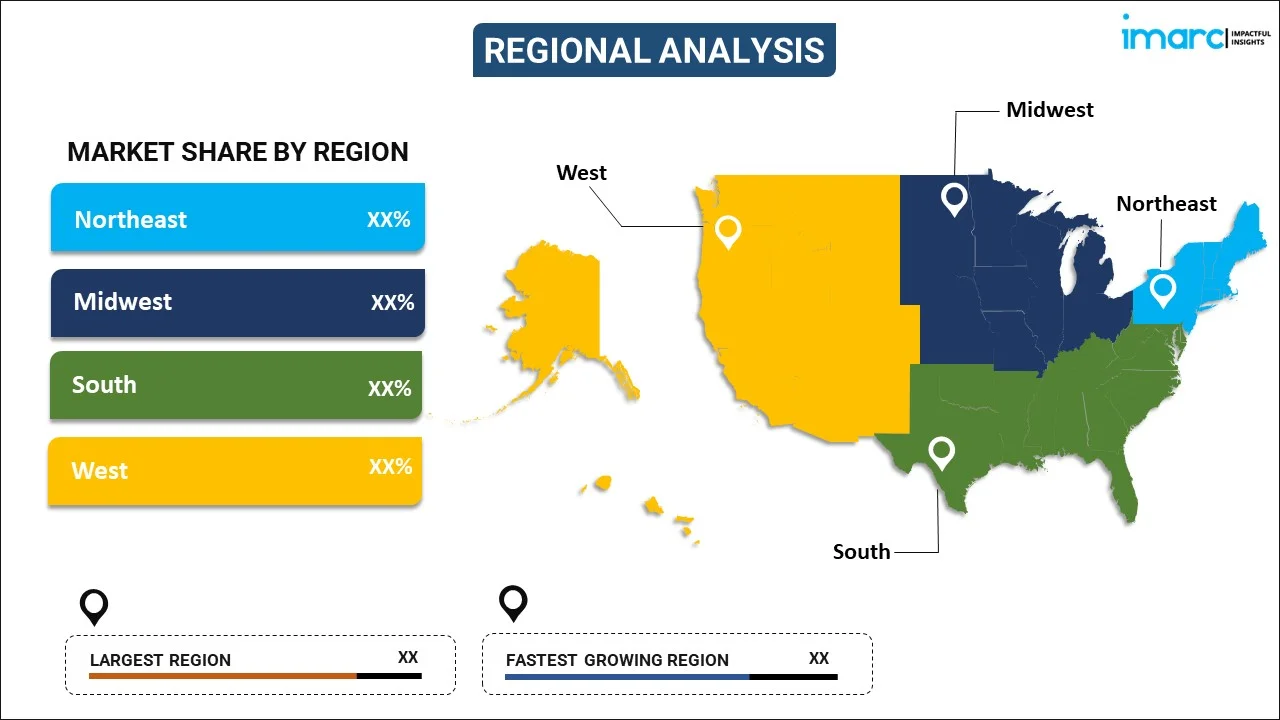
United States Kosher Food Market Report by Type (Buckwheat, Seafood, Lamb, Pulses, and Others), Application (Culinary Products, Snacks and Savory, Bakery and Confectionery Products, Meat, Beverages, Dietary Supplements), Distribution Channel (Supermarkets and Hypermarkets, Grocery Stores, Online Stores), and Region 2025-2033
Market Overview:
The United States kosher food market size reached USD 5.5 Billion in 2024. Looking forward, IMARC Group expects the market to reach USD 7.1 Billion by 2033, exhibiting a growth rate (CAGR) of 2.9% during 2025-2033. The increasing awareness among individuals about health benefits, the rise of e-commerce sector, growing culinary innovations, and rising multiculturalism and diversity in the country represent some of the key factors driving the market.
|
Report Attribute
|
Key Statistics
|
|---|---|
|
Base Year
|
2024 |
|
Forecast Years
|
2025-2033
|
|
Historical Years
|
2019-2024
|
| Market Size in 2024 | USD 5.5 Billion |
| Market Forecast in 2033 | USD 7.1 Billion |
| Market Growth Rate (2025-2033) | 2.9% |
Kosher food refers to a specific category of food that adheres to the dietary laws of Kashrut, a set of regulations outlined in Jewish religious texts, particularly in the Torah. These guidelines dictate what foods are permissible and appropriate for consumption by Jewish individuals. Kosher food encompasses various items, including meats, dairy products, fruits, vegetables, and grains, each subject to specific preparation and consumption requirements. The significance of kosher food revolves around fulfilling religious and cultural obligations. It has also garnered a broader appeal due to its reputation for cleanliness, quality, and ethical sourcing. The demand for Kosher Food extends beyond the Jewish community, resonating with health-conscious consumers seeking transparency and authenticity in their dietary choices. It enhances mindfulness about food choices, fostering a connection to cultural heritage, and promoting a sense of dietary discipline. The process of selecting, preparing, and consuming kosher food items also encourages individuals to be more conscious of the origins and processing of their meals, potentially leading to more sustainable and ethically sourced food choices.
United States Kosher Food Market Trends:
The increasing awareness among consumers regarding the quality and sourcing of kosher food is one of the major factors contributing to the market growth. Kosher food follows stringent regulations and meticulous oversight that appeal to a demographic seeking assurance of ethical and clean production practices. In line with this, the growing contemporary concerns over food safety, animal welfare, and sustainability are positively impacting the market growth. Additionally, the significant growth in the e-commerce sector and rising digital connectivity, helps in expanding the accessibility of kosher food products offering consumers the convenience to explore and purchase a diverse array of certified products online, is providing a thrust to the market growth. Moreover, the increasing popularity of kosher food for its separation of dairy and meat products, promoting balanced and healthier eating habits as consumers become more attentive to the nutritional content of their meals, is creating a positive outlook for the market growth. In addition to this, the increasing culinary innovation as food manufacturers introduce a diverse range of innovative kosher products, such as gourmet convenience foods and artisanal kosher delicacies, expanding the demand beyond traditional categories is providing an impetus to the market growth. Furthermore, the growing multiculturalism and diversity which promotes individuals from different backgrounds to explore and appreciate Jewish traditions and culinary practices, is providing a considerable boost to the market growth.
United States Kosher Food Market Segmentation:
IMARC Group provides an analysis of the key trends in each segment of the United States kosher food market report, along with forecasts at the country level for 2025-2033. Our report has categorized the market based on type, application, and distribution channel.
Type Insights:

- Buckwheat
- Seafood
- Lamb
- Pulses
- Others
The report has provided a detailed breakup and analysis of the market based on the type. This includes buckwheat, seafood, lamb, pulses, and others.
Application Insights:
- Culinary Products
- Snacks and Savory
- Bakery and Confectionery Products
- Meat
- Beverages
- Dietary Supplements
A detailed breakup and analysis of the market based on the application has also been provided in the report. This includes culinary products, snacks and savory, bakery and confectionery products, meat, beverages and dietary supplements.
Distribution Channel Insights:
- Supermarkets and Hypermarkets
- Grocery Stores
- Online Stores
A detailed breakup and analysis of the market based on the distribution channel has also been provided in the report. This includes supermarkets and hypermarkets, grocery stores and online stores.
Regional Insights:

- Northeast
- Midwest
- South
- West
The report has also provided a comprehensive analysis of all the major regional markets, which include the Northeast, Midwest, South and West.
Competitive Landscape:
The report has also provided a comprehensive analysis of the competitive landscape in the market. Competitive analysis such as market structure, key player positioning, top winning strategies, competitive dashboard, and company evaluation quadrant has been covered in the report. Also, detailed profiles of all major companies have been provided.
United States Kosher Food Market Report Coverage:
| Report Features | Details |
|---|---|
| Base Year of the Analysis | 2024 |
| Historical Period | 2019-2024 |
| Forecast Period | 2025-2033 |
| Units | Billion USD |
| Scope of the Report | Exploration of Historical and Forecast Trends, Industry Catalysts and Challenges, Segment-Wise Historical and Predictive Market Assessment:
|
| Types Covered | Buckwheat, Seafood, Lamb, Pulses, Others |
| Applications Covered | Culinary Products, Snacks and Savory, Bakery and Confectionery Products, Meat, Beverages, Dietary Supplements |
| Distribution Channels Covered | Supermarkets and Hypermarkets, Grocery Stores, Online Stores |
| Regions Covered | Northeast, Midwest, South, West |
| Customization Scope | 10% Free Customization |
| Post-Sale Analyst Support | 10-12 Weeks |
| Delivery Format | PDF and Excel through Email (We can also provide the editable version of the report in PPT/Word format on special request) |
Key Questions Answered in This Report:
- How has the United States kosher food market performed so far and how will it perform in the coming years?
- What has been the impact of COVID-19 on the United States kosher food market?
- What is the breakup of the United States kosher food market on the basis of type?
- What is the breakup of the United States kosher food market on the basis of application?
- What is the breakup of the United States kosher food market on the basis of distribution channel?
- What are the various stages in the value chain of the United States kosher food market?
- What are the key driving factors and challenges in the United States kosher food market?
- What is the structure of the United States kosher food market and who are the key players?
- What is the degree of competition in the United States kosher food market?
Key Benefits for Stakeholders:
- IMARC’s report offers a comprehensive quantitative analysis of various market segments, historical and current market trends, market forecasts, and dynamics of the United States kosher food market from 2019-2033.
- The research study provides the latest information on the market drivers, challenges, and opportunities in the United States kosher food market.
- Porter's five forces analysis assist stakeholders in assessing the impact of new entrants, competitive rivalry, supplier power, buyer power, and the threat of substitution. It helps stakeholders to analyze the level of competition within the United States kosher food industry and its attractiveness.
- Competitive landscape allows stakeholders to understand their competitive environment and provides an insight into the current positions of key players in the market.
Need more help?
- Speak to our experienced analysts for insights on the current market scenarios.
- Include additional segments and countries to customize the report as per your requirement.
- Gain an unparalleled competitive advantage in your domain by understanding how to utilize the report and positively impacting your operations and revenue.
- For further assistance, please connect with our analysts.
 Inquire Before Buying
Inquire Before Buying
 Speak to an Analyst
Speak to an Analyst
 Request Brochure
Request Brochure
 Request Customization
Request Customization




.webp)




.webp)












